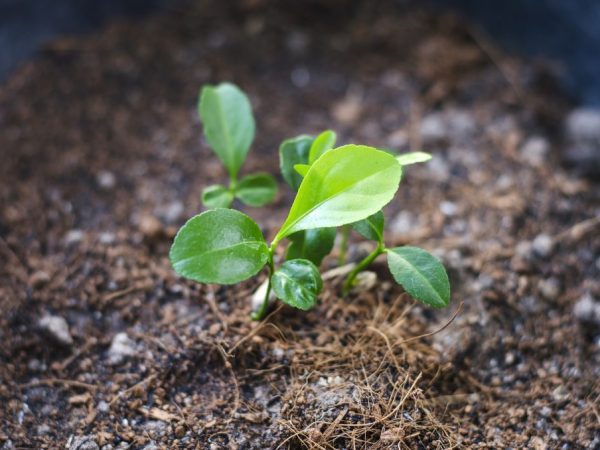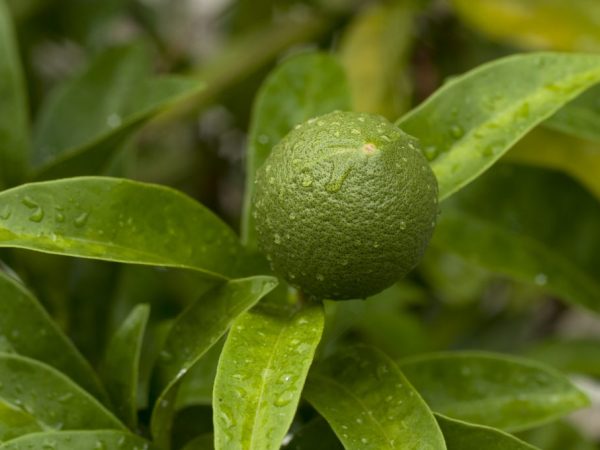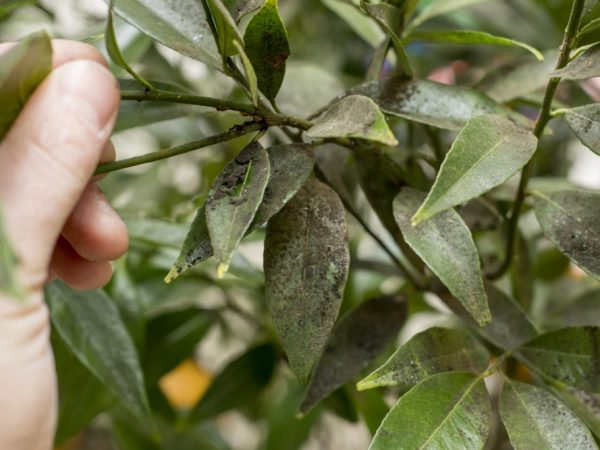Growing indoor lemon
Lemon is a subtropical plant. The evergreen tree delights with its bright foliage and fragrant flowers. Indoor lemon is a beautiful ornamental plant, growing it at home requires a bright, ventilated room, reliable drainage and regular feeding.

Growing indoor lemon
Characteristics of the variety
Features of indoor lemon:
- undersized tree up to 2 m;
- has thorny branches;
- leathery, elongated leaves, oval in shape, containing essential oils;
- leaves of a rich emerald color;
- forms white rosettes with yellow stamens 4 cm in diameter;
- emits a delicate, lemon scent that refreshes rooms;
- bud development - 5 weeks;
- bears fruit from 1 to 4 times a year;
- fruits of light yellow color;
- the pulp is juicy and sour.
According to the description, ovaries, buds, flowers and fruits develop simultaneously on the tree. The flowering of the bush with proper care is long lasting. In winter, it has a dormant period, so it begins to bloom in the spring.
The flowers have 5 small petals - 3 cm in diameter. Dusting the lemon is not required. Fruits ripen from 6 to 12 months. The abundant appearance of buds is possible only with proper care for indoor lemon at home.
Lemon varieties
For growing indoor lemon, crop varieties are chosen that are distinguished by good adaptive qualities. For the southern regions, choose: Lisbon, Genoa and Meyer. If the cultivation of indoor lemon occurs in the northern regions, then the varieties are suitable: Ponderoza, Pavlovsky and Lunario. Each representative differs in the appearance and size of the fruit.
| room | Variety | Description |
| 1 | Pavlovsky | The birthplace of the species is the village of Pavlovo, near Nizhny Novgorod. The bush grows up to 2 m. Its crown is rounded up to 1 m in diameter. Ripens 30 fruits per year. The peel is rough, 4.5 mm wide. The weight of the fruit is 120-130g, but there are instances of 400g. The variety does not like bright sunlight |
| 2 | Meyer | The dwarf version of lemons reaches 1.5 m. Forms spherical dense crowns and a small number of thorns. Bright yellow or orange fruits weigh up to 200g. The pulp is sour with little bitterness. |
| 3 | Novogruzinsky | Grows up to 3 m in height. The crowns of the representatives of the species are spreading with thorns. Thin peel and round fruits weighing up to 140 g. Produces about 150 delicious fruits per year, pitted. |
| 4 | Lisbon | It has a large crown, a large number of thorns, and strong branches. The yield per year is about 60 fruits. Fruit weight 130-150 g. The peel is thick, yellow, slightly ribbed. |
| 5 | Lisa | The miniature citrus tree begins to bear fruit in late August. One lemon, about 4 cm thick, with a thin peel. It smells soft. |
| 6 | Genoa | Reaches a height of up to 1.3 m. Has a dense crown, without thorns. The fruit weighing about 130 g is elongated with a green-yellow skin. Up to 150 fruits are harvested per year. |
| 7 | Ponderosa | The hybrid plant is highly resistant to heat. Representatives grow up to 1.8 m in height.They have a spreading crown and oval fruits weighing about 450 g. Rough and thick peel. |
Among indoor lemons, types are also popular under the names:
- Anniversary;
- New Zealand;
- Ural;
- Mezensky.
Growing lemon
Growing requirements

The plant does not tolerate temperature changes
To grow a healthy plant, choose the right place in your apartment. The survival rate of the seedling and disease resistance depend on this. Indoor lemon does not tolerate temperature changes, it begins to crumble. Therefore, the temperature of the entire room should be kept stable. When placing the flowerpot on the windowsill, make sure that they do not burn the leaves. The most ideal option for placing a flowerpot will be a bay window, where the lighting is even.
In winter, the citrus tree requires low temperatures - 5–10 ° C to ensure the dormant stage. And it doesn't like a change of scenery.
Landing in the soil
To grow a lemon as a houseplant without any problems, you need to choose the right container for planting, choose a substrate and adhere to the planting rules. A pot for planting is chosen from any material: plastic, wood, metal, etc. But the top diameter of the container should be no more than 15 cm, and the bottom should have several holes.
Experts recommend choosing a pot with a height of about 20 cm. And after 6 months, use a higher flowerpot. Drainage is placed at the bottom of the pot with a layer of 3-5 cm. It consists of wood ash and sand. Ashes are poured onto the bottom with a layer of about 3 cm, then covered with sand by 2 cm.
The growing substrate should not be from the garden, but prepared or purchased in the store. To prepare the soil at home, use:
- 2 cups of forest soil;
- a glass of sand;
- 3 tbsp. l. humus;
- 1 tbsp. l. wood ash.
All ingredients are mixed and stirred in water until a creamy mass. The mixture is placed in a pot so that the root system is completely covered with soil.
Lemon propagation
To breed indoor lemon, 4 methods are used:
- cuttings;
- reproduction by layering;
- seeds;
- vaccinations.
Usually grown by cuttings, this is the most successful method for citrus fruits. Cuttings are carried out in spring and summer. To do this, take a branch of a plant with 3 leaves. It is treated with a heteroauxin stimulant from below and planted in sandy soil. The stalk is sprayed with water and a glass jar is placed on top. Spray the seedling every day. After the appearance of new shoots, the bank is removed.
Oranges are also propagated by layering. The bark is removed from the branches, treated with a stimulant. Cover it with moss and sand and seal it with black polyethylene. After 2-3 months, the branch is cut off and planted in a separate container. There are three options for this method: Russian, Dutch and combi.
Vaccination can be:
- into cleavage;
- in the butt;
- into the bark.
Copulation is used when the stem of the stock and the grafted stalk are of the same thickness. The stalk and stock are cut at an angle. Placed together and wrapped with gauze. Then we plant the sprout in the soil of sand, wood ash and forest land.
When grown by seed, it is difficult to form a fruit. Therefore, it is worth carefully selecting the planting material. Choose the largest seed or several at once, which can be planted in a plastic glass with holes. For the substrate, sand and ash with earth are used. Watering is carried out immediately after planting.
Plant care

Proper care promotes good plant growth
It is necessary to care for indoor lemon, observing agrotechnical measures that will contribute to the formation of fruits and good growth of the tree.
| room | Agrotechnical event | Application |
| 1 | Lighting | Provide diffused bright light and a long day for the tree to grow. Direct sunlight negatively affects fruiting. With a lack of light, the leaves slow down growth, and the fruits become sour. |
| 2 | Pruning | Pruning in the fall increases the tree's fruiting, spring pruning strengthens the tree and increases fruiting, and pruning in winter causes minimal damage. The first pruning is carried out when the tree has reached 20 cm. First, the main trunk is cut, leaving 4 developed buds. After that, the shoots of the first and second order are cut to a height of 20-25 cm. |
| 3 | Watering | Moisten the soil regularly. In the summer, they are watered once a day, in the winter, once every 7 days. If the substrate crumbles into grains of sand, the plant is watered. Water for irrigation is used settled with a low chlorine content. The water temperature for irrigation is 30–35 ° С, especially in winter. The leaves are sprayed 1-2 times a day. |
| 4 | Transfer | They do it when there is not enough space in the pot, the plant is sick, has stopped growing. When transplanting, the plant, together with the earth, is placed in a new container, and the drug Kornevin is added to the soil. |
| 5 | Fertilizer | Top dressing is needed for the formation of fruits. For fertilizers, both organic matter and chemical preparations are used. In the first month after planting, the tree does not need to be fed, it does not need any fertilization. Only after 2 months they carry out top dressing of indoor lemon. Now it needs to be fertilized every 7-10 days:
In the spring, fertilize with urea: for 1 liter of water there is 1 teaspoon of urea. It should be fed in the summer once a month. Two hours before fertilization, the soil in the containers is watered. |
| 6 | Pruning | Prune the plant to form a crown and give growth to young shoots. |
Diseases and pests
Indoor lemon is exposed to various pests:
- scabbard - the leaves fall off, the branches dry out and the tree dies;
- aphid - eats the upper parts of the shoots;
- spider mite - manifested by a light cobweb and curling of leaves;
- mealybug - it feeds on greens, because of it the fruits crack;
- thrips - carry viruses and fly, destroy leaves and roots.
- Whitefly is located at the bottom of the leaves.
Insects also cause disease. The scabbard brings a sooty fungus to the plant. On the shoots, foliage becomes sticky and crystals form. If the plant is not treated, it becomes stained and dies.

Aphids destroy the tops of the shoots
Hommosis is a disease that manifests itself in the form of cracks, from which gum begins to stand out.
If the plant begins to shed its leaves abruptly, this is a sign of root rot.
Indoor lemon suffers most from fungal diseases:
- scab;
- sooty fungus;
- wart;
- anthracnose.
For viral infections (tristeza, leaf mosaic and citrus cancer), homemade lemon cannot be cured.
Fight disease
To eliminate sticky plaque, the leaves are wiped every 5-7 days with a solution of transformer oil. To do this, mix 6 ml of the substance and 1 liter of water. Garden var or clay is used against gommosis. Cracks are disinfected with a solution of copper sulfate 3%. And clay or var is applied to the wounds.
To treat root rot, all damaged areas are removed from the tree, it is transplanted and placed in a well-lit place and watering is limited to 5-7 days. The drug Fitosporin-M is used as a microbiological preparation against fungal diseases and as a prophylaxis.
Pest control
A soap solution is used against the scabbard. To do this, mix 1 liter of water and 2 tbsp. l. liquid product or 40 g of grated soap. Also, the leaves are washed with a garlic mixture: 7 crushed heads of garlic are added to a bucket of water.
To get rid of aphids and make the spider mite disappear, the plant is treated with apparatus three times every 10 days:
- Aktelik;
- Kleschevite;
- Akarin;
- Fitoverm.
It is also recommended to spray with a garlic solution and plant a pot of geraniums next to the tree. Scabbards, aphids and ticks are expelled using a chlorophos solution with the calculation of 30 g of substance per 10 liters. To destroy thrips, the bush is washed under the shower, treated with a soapy emulsion.Insecticides are used against whiteflies at least 5 times every three days.
If you take proper care of the plant, the risk of infection with diseases and the appearance of insects is minimized.
Conclusion
To grow indoor lemon that will bear fruit, strictly follow the rules of care. The tree contains essential oils of bactericidal action, volatile vapors ozonize the air, improve mood, and give vitality. Experts also recommend purchasing a special lighting lamp for the plant in order to reduce the risk of diseases due to a lack of regular sunlight.


